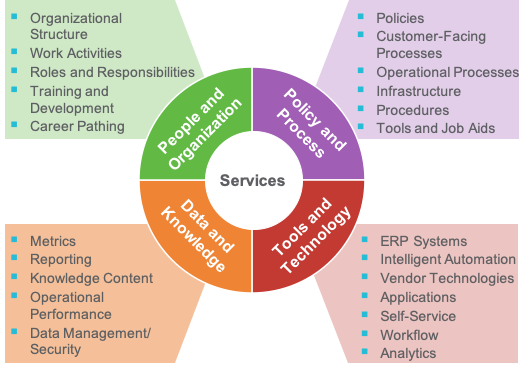
How HR Shared Services Can Help You Handle the Next Crisis
The Impact of a Pandemic
While the experts are learning more and more each day, no one can say with certainty when the COVID-19 pandemic will end. What is likely, however, is there will be lasting impact on the way businesses operate. What is an absolute certainty is that even with COVID-19 in the rear-view mirror, your service center should be an integral part of how your company efficiently and effectively supports your business during a crisis, be it pandemic, natural disaster, or normal business headwinds.
It would have been extremely helpful if we had a service center in place during this pandemic.
Chief Human Resources Officer
If COVID-19 disruption has exposed gaps in your operations, you are not alone. Almost half (43 percent) of shared services professionals claim that inadequate infrastructure and hardware limited their ability to deliver during this crisis, per SSON.1 Between dispersed work staff, policy and process changes, and possible governmental regulatory changes, you were thrown a curve ball, and chances are your organization looks different than it did six months ago. Are you satisfied with how your organization handled these rapid changes, and more importantly, are you prepared to handle the next crisis?
Below are suggestions on how to better prepare your service delivery infrastructure for the next crisis.
How Human Resources Must Adapt
HR’s role in the organization is primarily to define and lead the people strategy. HR is responsible for building programs and consulting clients across all employee-related activities, including, but not limited to, defining health and well-being practices, measuring employee engagement and identifying opportunities to improve, leading diversity and inclusion efforts, and consulting clients around organizational design efforts. Perhaps the most common activity people look to HR for is to manage the vast array of administrative tasks associated with employee management like hiring, terminations, pay increases, severance processing, and ensuring that regulatory measures are met. While these blocking-and-tackling HR activities have not gone away because of COVID-19, is there an opportunity to reimagine how they get done going forward? Almost certainly there is. How does HR and HR shared services (HRSS) enhance its ability to be agile and nimble, to be proactive in managing key activities critical during a crisis, as well as to quickly bring online new activities in support of business continuity when that curve ball is thrown?
| Talent Acquisition (TA)
HR needs to determine how to quickly implement video screening and interviewing practices and redefine the onboarding process with “virtual hiring” as the desired state, especially with significant remote or dispersed work. Another opportunity TA has is to provide employee outreach with recruiter-led training sessions to work on employee resumes and interview skills. Lastly, TA and HR can leverage this opportunity to manage the overall workforce across the organization. This includes contingent workers, repositioning and retooling non-essential staff, etc.
|
|
| Health and Wellness
There may be a need to revisit leave policies (PTO, unpaid leave, carry over, donating, etc.) and voluntary benefits, such as commuter and transportation programs, flexible work arrangements, wellness memberships, and employee assistance programs and how these are supported by HRSS.
|
|
| Learning and Development
This is an opportunity for HR to focus on upskilling current employees and managers specific to dealing with change and working with ambiguity. The need for health and safety training is heightened now (How quickly can this be designed and deployed?). In addition, they can provide offerings for personal development (e.g., learning a new language). |
In addition, HR needs to participate on the emergency response team, if your organization has established such a team to manage the work and changes associated with the pandemic. HR focuses on defining employee-related policies and ensures all decisions are equitable, empathetic, and legal.
Fully functioning service center launched ~ 2016
Approach:
Results:
|
 |
HR is being asked to support the business with reporting needs to help drive financial decisions. Without an organized HCM solution and dedicated team, this can be extremely manual and time consuming.
How Shared Services Can Drive Results
HR plays a crucial role in defining an organizational strategy. While administrative activities are often minimized, they are fundamental to a unified, cohesive HR organization, are critical to business operations, and directly impact the overall employee experience.
For many organizations, these administrative and transactional tasks are centralized in a service center as part of a shared services delivery model. This model can be extremely effective for delivering critical services to the organization, especially during a crisis. Our shared services clients typically have a 40 percent return on investment and are able to reduce headcount by 25 percent when implementing a shared services model.
The benefits of the shared services model include:
- Standard, automated, and more efficient processes
- Improved reporting and analytics, including performance metrics
- Improved compliance
- Economies of scale
- Better decision-making
During times of uncertainty, employees can feel unnerved and uneasy. They may feel unsure if their job is safe, guilty if theirs is and their colleague is furloughed, or have questions about benefits and technology needed to work remotely. Some service centers are even seeing increased call volume around non-COVID-19-related issues simply because employees have more time on their hands to inquire about that nagging issue they may have otherwise put off.
Simply put, employees need a dependable source to get information and their questions answered and a service center can do that—via an employee portal (direct access or self-service) or reliable, well-informed service reps. Direct access allows information to be available 24/7, enabling flexibility for the employee to access at their convenience.
Launched Wave 1 of service center in Q1 2020
Approach:
Results:
|
 |
The shared services delivery model is a common platform for expansion, which is a current trend but is also extremely beneficial given the quickly changing demands of an organization during disruptive events like pandemics or other crises. ScottMadden’s leading practices framework is a good starting point to evaluate the readiness of your shared services delivery model. Regardless of how mature your organization is, this four-quadrant approach can be applied to any organization.
By focusing on the components highlighted in this graphic, your organization can adapt to more effectively support your employees. The characteristics identified allow for seamless client service during a crisis and beyond. Many of the items identified can be implemented quickly and with little cost.

The concept of implementing, expanding, or improving a service center is simple. It does, however, take discipline, effective decision-making, and dedicated resources—simple yes, easy no!
| Component | Effectiveness during a Business Interruption |
| People and Organization | Having an effective training methodology in place allows for quick dissemination of process and policy details/changes. Solid, defined governance allows for quick decision-making in response to crisis. |
| Policy and Process | Well-designed policies and processes are scalable as well as nimble. Publishing job aids and internal process documentation ensures consistency and lessens answer-shopping. |
| Tools and Technology | The capability for people to work remotely is going to be crucial across the entire suite of HR service delivery, from service reps to generalists to specialists. Self-service capability allows the company to meet employees where they are. Automating processes, even those you have resisted, frees up people resources to focus on other more valuable activities. |
| Data and Knowledge | A knowledgebase with correct, regularly updated, targeted information is critical, especially during crisis. Real-time metrics about HRSS inquiries and status allows you to track operational effectiveness. |
Launched service center in Q1 2020
Approach:
Results:
|
 |
We’re getting by in spite of a fully functioning service center;
however, the risks include:
- Timely processes resulting in inaccuracies
- Poor employee experience
- Longer hours, employee burnout, and low morale
Operational Elements
Even with robust technology supporting it, people are the engine that makes a service center effective at supporting employees. In many companies, shared services employees are viewed as the “front line” of the organization given all the critical processes and information they support. Therefore, it is critical they are monitored in terms of work/life balance and employee morale.
With a distributed workforce here to stay, there is an opportunity for a more diverse workforce within the service center. However, the distributed model will introduce some challenges. Imagine a team of 13 working in 13 different locations. Employee engagement and bidirectional communication is essential to the success of your service center.
- Continue to have weekly or daily stand-up team meetings via web-based platforms
- Leverage collaboration tools to maintain and encourage communication across the team outside of team meetings
- Review scheduling and shift work to accommodate work/life balance and personal conflicts
- Remember each employee may have different needs or challenges
- Accommodate off-phone work to be done during off-hours
- Modify hours of operations to accommodate service reps as well as employees – employees are no longer working the standard 9-to-5 shift
- Ensure the team is taking advantage of the company benefits (childcare stipends, wellness, etc.)
- Facilitate engagement opportunities (team trivia, family game hour, educational opportunities)
- Share real-time metrics via dashboards, openly discuss service level agreements (SLAs) and key performance indicators (KPIs), and acknowledge stand-out performers
Effective governance is core to sustaining an HR service center, and establishing a strong governance model has never been more important. Governance can take many different forms from a detailed management model to a simple set of guidelines upon which leadership agrees to operate. Regardless of the model, it is crucial that key stakeholders within the HR organization are aligned on the service delivery offerings and involved in key decision-making. Metrics (including SLAs and KPIs) should be discussed openly within the governance team, as well as continuous improvement opportunities.
Service center launched in Q1 2020 along with new HCM solution
Approach:
Results:
|
 |
| “Our COVID-19 response would not have been possible prior to our SDM implementation. We are all so thankful for the work the team put in to make these systems operational and able to support us effectively.” –CHRO |
“…our ELT has repeatedly been astounded by what HR has been able to do with Workday and the myHR Portal. We’ve been turning on a dime in a split second every time a new need arises, and it’s really showing departments like EH&S and IT what a nimble service center looks like… so it’s been a bittersweet moment for everything we built to shine!” –Director, HR Operations |
Additional Reference Materials
- How HR Can Leverage the Employee Life Cycle When Needs Suddenly Change
- Five Keys to a Successful Shared Services Transformation
How ScottMadden Can Help
ScottMadden has worked extensively with leading national organizations. Partnering with clients to develop, implement, and enhance across multiple industries has allowed us to help you quickly respond and adapt in this ever-changing environment—today and into the future. Learn more about our human capital management services and ensure your success under the most pressing circumstances.
About ScottMadden’s Corporate & Shared Services Practice
ScottMadden has been a recognized leader in corporate and shared services since the practice began decades ago. Our Corporate & Shared Services practice has completed more than 1,900 projects since the early 90s, including hundreds of large, multi-year implementations. Our clients span a variety of industries from energy to healthcare to higher education to retail. Examples of our projects include service delivery strategy and business case development, corporate service assessment and improvement, shared services design, shared services implementation, and shared services improvement.















































































